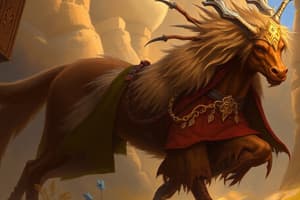Podcast
Questions and Answers
What is the main theme of Beowulf?
What is the main theme of Beowulf?
The conflict between good and evil
Who is the evil monster terrorizing the Heorot?
Who is the evil monster terrorizing the Heorot?
Grendel
What is the name of the land ruled by Beowulf when he becomes king?
What is the name of the land ruled by Beowulf when he becomes king?
Geatland
Who does Beowulf kill with a magic sword?
Who does Beowulf kill with a magic sword?
How does Beowulf die?
How does Beowulf die?
What does Beowulf ask to be done with his body before he dies?
What does Beowulf ask to be done with his body before he dies?
What was the role of the scop in Anglo-Saxon literature?
What was the role of the scop in Anglo-Saxon literature?
What language were most of the Anglo-Saxons' literature stories told in?
What language were most of the Anglo-Saxons' literature stories told in?
What is the caesura in Anglo-Saxon poetry?
What is the caesura in Anglo-Saxon poetry?
Explain the significance of alliterative verse in Anglo-Saxon poetry.
Explain the significance of alliterative verse in Anglo-Saxon poetry.
What is a kenning in Anglo-Saxon literature?
What is a kenning in Anglo-Saxon literature?
How did monks contribute to the preservation of Anglo-Saxon literature?
How did monks contribute to the preservation of Anglo-Saxon literature?
Flashcards are hidden until you start studying
Study Notes
Anglo-Saxon Literature
- Anglo-Saxon poetry has oral traditions and was narrated by the scop, a poet and minstrel who played an important social function by singing about cultural values.
- Most of their literature was in poetry, with some in prose, and was written in Old English.
- After Christianization, monks transcribed the texts into Latin.
Characteristics of Anglo-Saxon Poetry
- A poem is divided into two halves with a different length, with a verse containing between 8 and 20 syllables.
- The caesura is a pause between the first half line and the second half line.
- Stresses (accents) are important for rhythm, with a fixed accent of 2 + 2 because the verse is divided into two parts.
- Alliterative verse is used, where all verses must contain at least one alliteration, which is the same as that present in the first half and in the second.
- Assonance is used to connect the two halves, with a repetition of the same vowel sound within the verse.
- Kenning is a metaphorical phrase used in place of a name or noun, such as "whale-road" for the sea.
Types of Anglo-Saxon Literature
- Epic poem: a long narrative text that talks about the brave deeds of a hero, such as Beowulf.
- Elegy: a long narrative poem that talks about a sad tone, such as the loss of homeland or exile.
- Riddle: a short poem used as entertainment that speaks about different aspects and lifestyles of Anglo-Saxons, often using double meanings.
Beowulf
- Beowulf is the only epic poem to have survived, with over 3000 lines.
- It speaks about the gestures of a hero and gives information about Anglo-Saxon life.
- The transcription is in a manuscript called Cotton Vitellius, conserved in the British Library of the British Museum.
- The author is unknown, but it was probably composed by a single author for a Christian audience between the 8th and 11th centuries.
- The poem is set in Denmark, ruled by King Hrothgar, and Geatland, ruled by Beowulf when he becomes king.
Plot of Beowulf
- The hero must defeat three monsters: Grendel, Grendel's mother, and a dragon.
- Beowulf kills Grendel by tearing off its claw, and later kills Grendel's mother with a magic sword.
- 50 years later, Beowulf must fight a dragon that has been attacking his people, and he dies after being wounded by the dragon's poisonous claws.
- Before dying, Beowulf asks his friend to burn his body and bury him under a rock with the dragon's treasure.
Themes of Beowulf
- The hero is praised for his courage, strength, loyalty, and generosity.
- The poem exalts the conflict between good and evil and shows God's will is the same as fate.
- Beowulf risks his life to help the king, and the poem ends with his funeral.
Studying That Suits You
Use AI to generate personalized quizzes and flashcards to suit your learning preferences.




